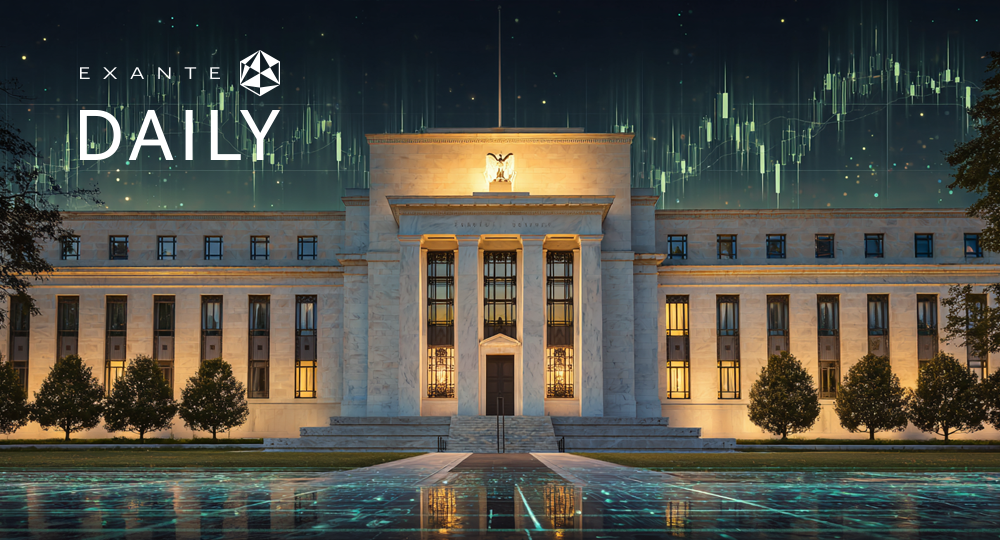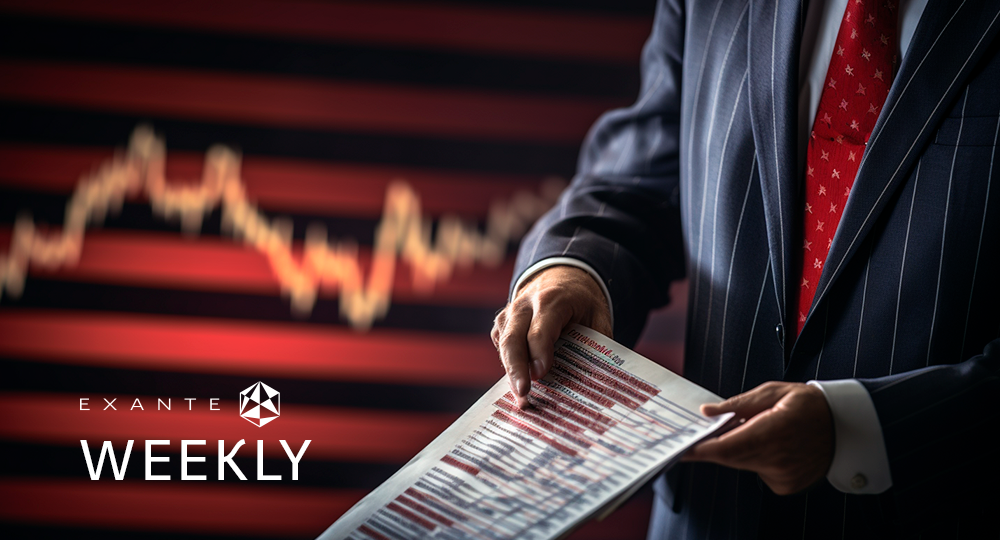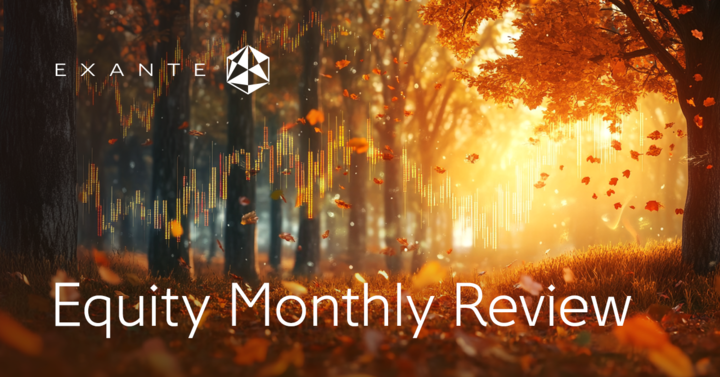
EXANTE Macro Insights

By Renée Friedman, PhD
The week in summary:
Welcome to Macro Insights #18. This week saw traders stepping in to “buy the dip” as energy prices cooled very slightly following an announcement by the United Arab Emirates and Iraq on Wednesday that they were open to increasing production and that they would speak to other OPEC members. Nevertheless, investors have been wavering on rising commodity prices and strong inflation data as they seek to understand the full impact the Russian-Ukrainian crisis will have on global supply-demand dynamics.
The introduction of tighter sanctions against Russia including the removal of some Russian banks from the SWIFT transfer system as well the exodus of some key name brands such as Toyota, KPMG, Heineken, Nike, Apple, Exxon, Ford, Zara, Netflix and Ikea from the Russian market means that Russia is increasingly being decoupled from the global commercial, technological and banking communities.
On Tuesday US President Biden Imposed an immediate ban on Russian oil and other energy imports. The UK said it would phase out imports of Russian oil and oil products by the end of 2022. Europe has so far held back from such sanctions for now. The EU is worried about its energy security. Despite energy prices, particularly gasoline, rising in the US to levels not seen since 2008, the US remains a net exporter of energy.
Also on Tuesday Russia threatened to cut natural gas supplies to Europe via the Nord Stream 1 pipeline. In response the EU is trying to rush through plans to reduce Europe’s dependence on Russian oil, which accounts for about 30% of all its oil supplies and gas, which accounts for about 40% of all gas supplies in Europe, by accelerating the green deal requirements to 2030 instead of 2050. However, many EU states simply do not have the financial resources required to meet the energy transition plans or the domestic political will as their populations have already had to deal with rapidly rising energy prices for the past 18 months. European governments have already spent tens of billions of euros attempting to protect consumers and industries from the surge in prices. All of this creates the potential for a highly stagflationary situation for Europe; surging energy and commodity costs, continuing supply constraints and the threat of increased shipping costs, and growing likelihood of food price inflation as key commodities such as wheat and potash, used in fertiliser production, mean that inflation will remain higher for longer while economic growth slows.
The ECB must have taken these risks into consideration when it decided to keep its interest rates unchanged and agreed to discontinue its net asset purchases under the PEPP at the end of March 2022. It has revised the purchase schedule for its APP such that monthly net purchases under the APP will amount to €40 billion in April, €30 billion in May and €20 billion in June. It said "If the incoming data support the expectation that the medium-term inflation outlook will not weaken even after the end of our net asset purchases, the Governing Council will conclude net purchases under the APP (Asset Purchase Programme) in the third quarter. “ In short it is winding down its asset purchase programme faster than it anticipated even a month ago. With inflation rising to fresh records and now seen averaging 5.1% this year, above the 3.2% predicted in December while in 2023, it is forecast at 2.1%, above a previous forecast of 1.8%), it had been under increasing pressure to remove this stimulus. The ECB did reiterate that they reserved the right to change actions if the medium term inflation outlook changes and if financing conditions become inconsistent towards their 2% target. ECB President Christine Lagarde was insistent that the ECB would be ready to adjust all its instruments to meet price stability requirements and to safeguard financial stability.
The pace of policy tightening by the US Federal Reserve (the Fed) announced at next week’s meeting on Wednesday will likely be one that shows consideration for the situation in Ukraine and the consequent impact on markets. Although the Fed is likely to proceed with a 25 basis point rate rise as suggested by Fed Chairman Jerome Powell, it will need to balance the threat of persistently high inflation (coming in at 7.9% in February, up from 7.5% in January) and the potential slowdown in growth due to rising commodity prices and waning consumer sentiment as inflation bites into real wages, despite a very tight labour market. The Fed may also suggest that it will ramp up the pace of tightening to 50 basis point increases in future meetings if inflation continues to rise well above target in medium term projections. The Fed may be more worried by changing inflation expectations and the possibility of a longer, drawn out period of lower growth than one short sharp shock that could reduce inflation relatively quickly, albeit not without some significant pain to consumers as well as companies.
The Bank of England (BoE) is also due to meet next Thursday. Inflation was already stubbornly high before the outbreak of the Russian-Ukrainian crisis (5.5% in January), while labour markets remain tight and there is a threat of wages rising in response. The BoE will be under pressure to increase rates to help contain inflation although it may choose to do so at a slower pace as the effects of the surge in energy and other commodity prices, and the consequent expected rise in food prices, take hold. The expected drop in consumption will hit the pace of GDP growth over coming quarters.
Things to look out for this coming week
- In Europe on Friday there is German CPI and the Harmonised index of consumer prices and Spanish CPI. On Monday is Spanish retail sales data. The Eurogroup meeting is taking place on Tuesday. On Tuesday there is French CPI, Eurozone industrial production data, Eurozone ZEW economic sentiment survey, and German ZEW current situation and sentiment surveys. On Wednesday is the Eurozone Ecofin meeting. There is also Italian CPI data on Wednesday. On Thursday is the release of Eurozone HICP data which can be used to measure changes in purchasing trends and inflation in the Eurozone.
- In the US on Friday is the Michigan Consumer Sentiment Index. On Tuesday there is PPI data. On Wednesday is retail sales data. Also all markets will be watching the Fed’s interest rate decision on Wednesday and economic projections. On Thursday there is a raft of data including continuing and initial jobless claims, housing starts and building permits data, capacity utilisation, industrial production numbers, and the Philadelphia Fed manufacturing survey.
- In the UK on Friday there is GDP, industrial production and manufacturing production data, and trade balance data. On Tuesday are the claimant count rate and change data, average earnings data and the ILO unemployment rate. All of this will be closely watched by BoE rate setters to help determine if a tight labour market will indeed lead to a wage-inflation spiral. The Bank of England monetary policy rate decision is on Thursday.
The clocks move forward an hour on Sunday in the US as Daylight savings time ends there.
Climate vs growth?
With the prospect of stagflation rearing its ugly head in Europe and a slowdown in the pace of growth in the US and elsewhere as global trade is impacted by supply constraints and rising shipping costs, the focus on climate change may no longer seem as relevant. Both countries and investors are focused on these more immediate economic concerns and are at risk of relegating climate policy to the fringes. According to Jean Pisani-Ferry “governments everywhere have rushed to introduce various patches in the hope of stemming the rise in the price level. According to a survey by Brussels-based economic think tank Bruegel, many in the EU have reduced energy taxes or levies, thus de facto lowering the price of carbon at a time when they should be contemplating how to increase it.” Continuing on this path, even in the near term, would be shortsighted thinking.
On 28 February the Intergovernmental Panel on Climate Change (IPCC) released a report stating that the “the extent and magnitude of climate change impacts are larger than estimated in previous assessments.” The IPCC estimates that in the next decade alone, climate change will jeopardise food security, something that, following the outbreak of the Russian-Ukrainian crisis and the impact it will have on food production and availability in Europe and in China among other regions, has come even more to the forefront as both an economic growth and geopolitical security concern. Global CO2 emissions rebounded in 2021 to reach their highest annual level. Emissions increased by almost 2.1 Gt from 2020 levels. The recovery of energy demand in 2021 and the consequent impact on prices was compounded by adverse weather, low supplies, and insufficient storage. Although 2020 and 2021 saw an increasing number of promises by countries to set a net zero target, more coal was burnt in 2021 despite renewable power generation registering its largest-ever annual growth. The 6% increase in CO2 emissions in 2021 was in line with the jump in global economic output of 5.9%.
However, the turmoil the Russian-Ukrainian crisis has created in energy and other commodity markets should make the case for improving commitments to ESG investing and deeper de-carbonisation. Clean energy provisions in the EU recovery package may provide significant mitigation impacts in the coming years. And, on Tuesday 8 March, when it seemed no one was looking, European carbon futures rose 18% while wind and solar energy stocks soared, following news that the EU’s plans to cut its dependence on Russian natural gas were to be accelerated. And, as noted by Bloomberg asset managers are coming under renewed pressure to blacklist gas from ESG funds as activists slam European plans to call the fossil fuel “green” despite the events in Ukraine exposing the region’s energy dependence on Russia.
So there is the possibility that if countries and investors think about the longer term relationships between energy supply and critical resources such as food development capacity, and do continue to focus on real ESG friendly investments, both positive growth and better climate outcomes may be achieved which may, down the line reduce overall geopolitical risks.
DISCLAIMER: While every effort has been made to verify the accuracy of this information, EXT Ltd. (hereafter known as “EXANTE”) cannot accept any responsibility or liability for reliance by any person on this publication or any of the information, opinions, or conclusions contained in this publication. The findings and views expressed in this publication do not necessarily reflect the views of EXANTE. Any action taken upon the information contained in this publication is strictly at your own risk. EXANTE will not be liable for any loss or damage in connection with this publication.
本文提供给您仅供信息参考之用,不应被视为认购或销售此处提及任何投资或相关服务的优惠招揽或游说。金融工具交易存在重大亏损风险,未必适合所有投资者。过往表现并非未来业绩的可靠指标。




